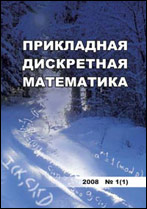|
Applied Graph Theory
About uniqueness of the minimal $1$-edge extension of hypercube $Q_4$
A. A. Lobov, M. B. Abrosimov
Saratov State University, Saratov, Russia
Abstract:
One of the important properties of reliable computing systems is their fault tolerance. To study fault tolerance, we can use the graph theory. In this paper, minimal edge extensions of graph are considered as a model for studying the failure of links in a computing system. A graph $G^*$ is a $k$-edge extension of a graph $G$ if every graph obtained by removing any $k$ edges from $G^*$ contains $G$. A $k$-edge extention $G^*$ of graph $G$ is said to be minimal if it contains $n$ vertices, where $n$ is the number of vertices of $G$, and $G^*$ has the minimum number of edges among all $k$-edge extensions of graph $G$ with $n$ vertices. The hypercube $Q_n$ is a regular $2^n$-vertex graph of order $n$, which is the Cartesian product of $n$ complete $2$-vertex graphs $K_2$. We propose a family of graphs $Q^*_n$ whose representatives for $n>1$ are minimal $1$-edge extensions of the corresponding hypercubes. In this paper, we provide an analytical proof of the uniqueness of minimal $1$-edge extensions of hypercubes for $n \leq 4$, as well as establishing one general property of an arbitrary minimal $1$-edge extension of a hypercube $Q_n$ for $n > 2$: it does not contain edges connecting vertices, the distance between which in the hypercube is equal to $2$.
Keywords:
graph, hypercube, edge fault tolerance, minimal $1$-edge extension.
Citation:
A. A. Lobov, M. B. Abrosimov, “About uniqueness of the minimal $1$-edge extension of hypercube $Q_4$”, Prikl. Diskr. Mat., 2022, no. 58, 84–93
Linking options:
https://www.mathnet.ru/eng/pdm787 https://www.mathnet.ru/eng/pdm/y2022/i4/p84
|

|




 Contact us:
Contact us: Terms of Use
Terms of Use
 Registration to the website
Registration to the website Logotypes
Logotypes








 Citation in format
Citation in format 